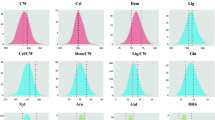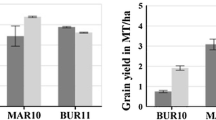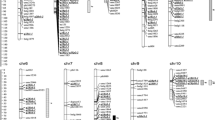Abstract
While maize silage is a significant feed component in animal production operations, little information is available on the genetic bases of fiber and lignin concentrations in maize, which are negatively correlated with digestibility. Fiber is composed largely of cellulose, hemicellulose and lignin, which are the primary components of plant cell walls. Variability for these traits in maize germplasm has been reported, but the sources of the variation and the relationships between these traits in different tissues are not well understood. In this study, 191 recombinant inbred lines of B73 (low-intermediate levels of cell wall components, CWCs) × De811 (high levels of CWCs) were analyzed for quantitative trait loci (QTL) associated with CWCs in the leaf sheath. Samples were harvested from plots at two locations in 1998 and one in 1999 and assayed for neutral detergent fiber (NDF), acid detergent fiber (ADF) and acid detergent lignin (ADL). QTL were detected on all ten chromosomes, most in tissue specific clusters in concordance with the high genotypic correlations for CWCs within the same tissue. Adjustment of NDF for its subfraction, ADF, revealed that most of the genetic variation in NDF was probably due to variation in ADF. The low to moderate genotypic correlations for the same CWC across leaf sheath and stalk tissues indicate that some genes for CWCs may only be expressed in certain tissues. Many of the QTL herein were detected in other populations, and some are linked to candidate genes for cell wall carbohydrate biosynthesis.

Similar content being viewed by others
References
Austin DF, Lee M, Veldboom LR, Hallauer AR (2000) Genetic mapping in maize with hybrid progeny across testers and generations: grain yield and grain moisture. Crop Sci 40:30–39
Beavis WD (1994) The power and deceit of QTL experiments: lessons from comparative QTL studies. In: 49th Annual Corn and Sorghum Industry Research conference. ASTA, Washington, pp 250–266
Beeghly HH, Coors JG, Lee M (1997) Plant fiber composition and resistance to European corn borer in four maize populations. Maydica 42:297–303
Bosch L, Casañas F, Ferret A, Sánchez E, Nuez F (1994) Screening tropical maize populations to obtain semiexotic forage hybrids. Crop Sci 34:1089–1096
Cardinal A, Lee M, Moore KJ (2003) Genetic mapping and analysis of quantitative trait loci (QTL) affecting fiber and lignin content in maize. Theor Appl Genet 106:866–874
Causse M, Rocher J, Henry AM, Charcosset A, Prioul J, de Vienne D (1995) Genetic dissection of the relationship between carbon metabolism and early growth in maize, with emphasis on key-enzyme loci. Mol Breed 1:259–272
Causse M, Santoni S, Damerval C, Maurice A, Charcosset A, Deatrick J, de Vienne D (1996) A composite map of expressed sequences in maize. Genome 39:418–432
Cochran WG, Cox GM (1957) Experimental designs, 2nd edn. Wiley, New York
Delmer DP, Amor Y (1995) Cellulose biosynthesis. Plant Cell 7:987–1000
Delmer DP, Haigler CH (2002) The regulation of metabolic flux to cellulose, a major sink for carbon in plants. Metab Eng 4:22–28
Fehr WR (ed) (1987) Principles of cultivar development. Vol. 1: Theory and technique. McGraw-Hill, USA
Gaut BS (2001) Patterns of chromosomal duplication in maize and their implications for comparative maps of the grasses. Genome Res 11:55–66
Georges MD, Nielsen D, Mackinnon M, Mishra A, Okimoto R, Pasquino AT, Sargeant LS, Sorensen A, Steele MR, Zhoa Z, Womack JE, Hoeschele I (1995) Mapping quantitative trait loci controlling milk production in dairy cattle by exploiting progeny testing. Genetics 139:907–920
Helentjaris T, Weber D, Wright S (1988) Identification of genomic locations of duplicate nucleotide sequences in maize by analysis of restriction fragment length polymorphisms. Genetics 118:353–363
Holland JB (1998) EPISTACY: a SAS program for detecting two-locus epistatic interactions using genetic marker information. J Hered 89:374–375
Hunt CW, Kezar W, Vinande R (1992) Yield, chemical composition, and ruminal fermentability of corn whole plant, ear, and stover as affected by hybrid. J Prod Agric 5:286–290
Hunter RB (1978) Selection and evaluation procedures for whole-plant corn silage. Can J Plant Sci 58:661–678
Jansen RC, Stam P (1994) High resolution of quantitative traits with multiple loci via interval mapping. Genetics 136:1447–1455
Jiang C, Zeng Z-B (1995) Multiple trait analysis of genetic mapping for quantitative trait loci. Genetics 140:1111–1127
Knapp SJ, Stroup WW, Ross WM (1985) Exact confidence intervals for heritability on a progeny mean basis. Crop Sci 25:192–194
Krakowsky MD, Beeghly HH, Coors JG, Lee M (2003) Characterization of quantitative trait loci affecting fiber and lignin in maize (Zea mays L). Maydica 48:283–292
Krakowsky MD, Lee M, Coors JG (2005) Quantitative trait loci for cell wall components in recombinant inbred lines of maize (Zea mays L.) I: stalk tissue. Theor Appl Genet 111:337–346
Lande R, Thompson R (1990) Efficiency of marker-assisted selection in the improvement of quantitative traits. Genetics 124:743–756
Lander ES, Green P, Abrahamson J, Barlow A, Daly MJ, Lincoln ES, Newburg L (1987) MAPMAKER: an interactive computer package for constructing primary genetic linkage maps of experimental and natural populations. Genomics 1:174–181
Lübberstedt T, Melchinger AE, Klein D, Degenhardt H, Paul C (1997) QTL mapping in testcrosses of European flint lines of maize: II. Comparison of different testers for forage quality traits. Crop Sci 37:1913–1922
Lundvall JP, Buxton DR, George JR (1994) Forage quality variation among maize inbreds: in vitro digestibility and cell-wall components. Crop Sci 34:1672–1678
Méchin V, Argillier O, Hébert Y, Guingo E, Moreau L, Charcosset A, Barrière Y (2001) Genetic analysis and QTL mapping of cell wall digestibility and lignification in silage maize. Crop Sci 41:690–697
Mode CJ, Robinson HF (1959) Pleiotropism and the genetic variance and covariance. Biometrics 15:518–537
Papst C, Bohn M, Utz HF, Melchinger AE, Klein D, Eder J (2004) QTL mapping for European corn borer resistance (Ostrinia nubilalis Hb.), agronomic and forage quality traits of testcross progenies in early-maturing European maize (Zea mays L.) germplasm. Theor Appl Genet 108:1545–1554
Preiss J (1982) Regulation of the biosynthesis and degradation of starch. Ann Rev Plant Physiol 33:431–454
Prioul JL, Pelleschi S, Séne M, Thévenot C, Causse M, deVienne D, Leonardi A (1999) From QTLs for enzyme activity to candidate genes in maize. J Exp Bot 50:1281–1288
Roth LS, Marten GC, Compton WA, Stuthman DD (1970) Genetic variation of quality traits in maize (Zea mays L.) forage. Crop Sci 10:365–367
SAS Institute (1999) SAS OnlineDoc®, Version 8. SAS Institute, Inc, Cary, NC
Senior ML, Murphy JP, Goodman MM, Stuber CW (1996) Utility of SSRs for determining genetic similarities and relationships in maize using an agarose gel system. Crop Sci 38:1088–1098
Utz HF, Melchinger AE (1996) PLABQTL: a program for composite interval mapping of QTL. JQTL 2:1
Utz HF, Melchinger AE, Schön CC (2000) Bias and sampling error of the estimated proportion of the genotypic variance explained by quantitative trait loci determined from experimental data in maize using cross validation and validation with independent samples. Genetics 154:1839–1849
van Ooijen JW (1992) Accuracy of mapping quantitative trait loci in autogamous species. Theor Appl Genet 84:803–811
van Soest PJ (1994) Nutritional ecology of the ruminant, 2nd edn. Cornell University Press, Ithaca
Visscher PM, Thompson R, Haley CS (1996) Confidence intervals in QTL mapping by bootstrapping. Genetics 143:1013–1020
Wang S, Basten CJ, Zeng Z-B (2005) QTL cartographer version 2.5. Department of Statistics, North Carolina State University, Raleigh, N. C. Whetten R, Sederoff R (1998) Lignin biosynthesis. Plant Cell 7:1001–1013
Whetten R, Sederoff R (1998) Lignin biosynthesis. Plant Cell 7:1001–1013
Wolf DP, Coors JG, Albrecht KA, Undersander DJ, Carter PR (1993a) Forage quality of maize genotypes selected for extreme fiber concentrations. Crop Sci 33:1353–1359
Wolf DP, Coors JG, Albrecht KA, Undersander DJ, Carter PR (1993b) Agronomic evaluations of maize genotypes selected for extreme fiber concentrations. Crop Sci 33:1359–1365
Zeng Z (1994) Precision mapping of quantitative trait loci. Genetics 136:1457–1468
Acknowledgement
Research conducted in partial fulfillment of the Ph.D. degree by M. D. Krakowsky. This journal paper of the Iowa Agriculture and Home Economics Experiment Station, Ames, Iowa, Project No. 3134, was supported by Hatch Act and State of Iowa funds and The R. F. Baker Center for Plant Breeding.
Author information
Authors and Affiliations
Corresponding author
Additional information
Communicated by D. Hoisington
Rights and permissions
About this article
Cite this article
Krakowsky, M., Lee, M. & Coors, J. Quantitative trait loci for cell wall components in recombinant inbred lines of maize (Zea mays L.) II: leaf sheath tissue. Theor Appl Genet 112, 717–726 (2006). https://doi.org/10.1007/s00122-005-0175-0
Received:
Accepted:
Published:
Issue Date:
DOI: https://doi.org/10.1007/s00122-005-0175-0




